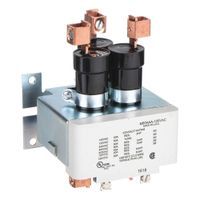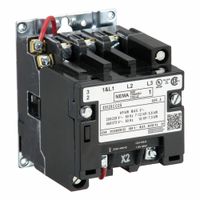Call +(254) 703 030 000 / 751 483 999 / 721 704 777
- Home
- Electrical
- Motor Controls
- Contactors Overload Relays
.....Read More
Frequently Asked Questions
What is the difference between IEC and NEMA contactors?
IEC (International Electrotechnical Commission) and NEMA (National Electrical Manufacturers Association) contactors differ primarily in design standards, application focus, and performance criteria.
1. **Design Standards**:
- IEC contactors are designed according to international standards, focusing on global applicability. They emphasize compact size, efficiency, and are often used in environments where space is limited.
- NEMA contactors adhere to North American standards, prioritizing robustness and durability. They are typically larger and designed to handle more demanding conditions.
2. **Performance Criteria**:
- IEC contactors are rated based on operational current and are categorized by utilization categories (e.g., AC-1, AC-3) that define their suitability for different types of loads.
- NEMA contactors are rated by horsepower and voltage, providing a more straightforward selection process for specific motor applications.
3. **Application Focus**:
- IEC contactors are often used in applications where efficiency and space-saving are critical, such as in control panels and automated systems.
- NEMA contactors are preferred in heavy-duty applications, such as industrial machinery, where reliability and longevity are crucial.
4. **Size and Cost**:
- IEC contactors are generally smaller and less expensive, making them suitable for cost-sensitive projects.
- NEMA contactors, being larger and more robust, tend to be more expensive but offer greater durability.
5. **Maintenance and Replacement**:
- IEC contactors often have replaceable components, allowing for easier maintenance.
- NEMA contactors are typically more straightforward to replace as entire units, focusing on minimizing downtime.
In summary, the choice between IEC and NEMA contactors depends on the specific requirements of the application, including size constraints, environmental conditions, and cost considerations.
How do overload relays protect motors?
Overload relays protect motors by monitoring the current flowing through the motor circuit and interrupting the circuit if the current exceeds a predetermined level for a specific period. They are designed to prevent motor damage due to overheating, which can occur from excessive current draw. Overload relays are typically part of a motor starter assembly and work in conjunction with contactors.
There are two main types of overload relays: thermal and electronic.
1. **Thermal Overload Relays**: These rely on the principle of thermal expansion. They consist of a bimetallic strip or a heater element that heats up as current flows through it. If the current exceeds the safe limit, the heat causes the bimetallic strip to bend or the heater element to expand, triggering a mechanical mechanism that opens the relay contacts, cutting off power to the motor. This process is time-dependent, allowing for short-term current surges without tripping, which is useful for handling motor start-up currents.
2. **Electronic Overload Relays**: These use current transformers and electronic circuits to measure the current. They offer more precise protection by allowing for adjustable trip settings and can provide additional features like phase loss protection, phase imbalance protection, and ground fault protection. Electronic relays can also communicate with control systems for advanced monitoring and diagnostics.
Both types of relays are designed to mimic the thermal characteristics of the motor, ensuring that the motor is protected from sustained overloads that could cause overheating and damage. By interrupting the power supply during overload conditions, overload relays help extend the life of the motor, reduce downtime, and prevent costly repairs.
What are the applications of definite purpose contactors?
Definite purpose contactors are specialized electrical devices designed for specific applications, primarily in the control of electric motors and other electrical loads. Their applications include:
1. **HVAC Systems**: Used extensively in heating, ventilation, and air conditioning systems to control compressors, fans, and blowers. They ensure efficient operation by managing the power supply to these components.
2. **Refrigeration**: Employed in refrigeration units to control compressors and other components, ensuring precise temperature regulation and energy efficiency.
3. **Pumps**: Utilized in water pumps, pool pumps, and industrial pumping systems to manage the start and stop functions, providing reliable operation and protection against overloads.
4. **Lighting Control**: Applied in commercial and industrial lighting systems to control large lighting loads, enabling energy savings and automated lighting schedules.
5. **Conveyors**: Used in conveyor systems to control motors, ensuring smooth operation and the ability to handle varying loads and speeds.
6. **Compressors**: Essential in air compressor systems for starting and stopping the compressor motor, maintaining pressure levels, and protecting against electrical faults.
7. **Industrial Machinery**: Implemented in various industrial machines to control motors and other electrical components, ensuring safe and efficient operation.
8. **Food and Beverage Equipment**: Used in equipment like ovens, fryers, and mixers to control heating elements and motors, ensuring consistent performance and safety.
9. **Agricultural Equipment**: Applied in irrigation systems and other agricultural machinery to control pumps and motors, enhancing productivity and reliability.
10. **Renewable Energy Systems**: Utilized in solar and wind energy systems to manage power distribution and protect against electrical faults.
Definite purpose contactors are valued for their reliability, cost-effectiveness, and ability to handle specific load requirements, making them indispensable in various sectors.
How do you select the right contactor for a motor starter assembly?
To select the right contactor for a motor starter assembly, consider the following factors:
1. **Motor Specifications**: Determine the motor's full load current (FLC), voltage, and power rating. This information is crucial for selecting a contactor that can handle the motor's electrical demands.
2. **Contactor Rating**: Choose a contactor with a current rating that exceeds the motor's FLC. Typically, a contactor should be rated at 115% to 125% of the motor's FLC to ensure reliability and longevity.
3. **Utilization Category**: Identify the utilization category (e.g., AC-1, AC-3, AC-4) based on the motor's application. AC-3 is commonly used for squirrel-cage motors with infrequent starting, while AC-4 is for motors with frequent starting and stopping.
4. **Voltage Rating**: Ensure the contactor's voltage rating matches or exceeds the motor's operating voltage. This includes both the coil voltage and the contactor's main contacts.
5. **Environmental Conditions**: Consider the operating environment, such as temperature, humidity, and exposure to dust or corrosive substances. Select a contactor with appropriate protection (e.g., IP rating) for the environment.
6. **Coil Voltage**: Choose a contactor with a coil voltage compatible with the control circuit. Common coil voltages include 24V, 110V, 220V, and 380V AC or DC.
7. **Size and Mounting**: Ensure the contactor fits within the available space in the motor starter assembly and is compatible with the mounting method (e.g., DIN rail or panel mount).
8. **Brand and Standards**: Opt for reputable brands that comply with relevant standards (e.g., IEC, NEMA) to ensure quality and safety.
9. **Additional Features**: Consider additional features like auxiliary contacts, mechanical interlocks, or surge suppressors based on the application requirements.
10. **Cost and Availability**: Balance cost considerations with availability and lead time to ensure timely procurement and installation.
What are the benefits of using safety contactors?
Safety contactors offer several benefits in industrial and commercial applications, primarily focusing on enhancing safety, reliability, and operational efficiency.
1. **Enhanced Safety**: Safety contactors are designed to meet stringent safety standards, ensuring that machinery and equipment can be safely shut down in emergency situations. They provide reliable disconnection of power, reducing the risk of accidents and injuries.
2. **Fail-Safe Operation**: These contactors are built to fail in a safe manner, meaning that in the event of a malfunction, they default to a state that minimizes risk. This is crucial in preventing unintended machine start-ups or hazardous conditions.
3. **Compliance with Regulations**: Using safety contactors helps businesses comply with international safety standards and regulations, such as ISO 13849 and IEC 62061. This compliance is essential for legal and insurance purposes.
4. **Increased Reliability**: Safety contactors are engineered for high reliability and durability, often featuring redundant contacts and robust construction. This ensures consistent performance even in demanding environments.
5. **Diagnostic Capabilities**: Many safety contactors come with built-in diagnostic features that allow for real-time monitoring and fault detection. This aids in preventive maintenance and reduces downtime by allowing issues to be addressed before they lead to failures.
6. **Integration with Safety Systems**: They can be easily integrated into broader safety systems, including emergency stop circuits and safety relays, providing a comprehensive safety solution.
7. **Cost Efficiency**: By preventing accidents and reducing downtime, safety contactors can lead to significant cost savings over time. They also minimize the need for additional safety components, simplifying system design and reducing installation costs.
8. **Versatility**: Safety contactors are suitable for a wide range of applications, from simple motor control to complex automated systems, making them a versatile choice for various industries.
How do lighting contactors work in controlling lighting systems?
Lighting contactors are electromechanical devices used to control large lighting loads by switching circuits on and off. They operate by using a low-voltage control circuit to manage a high-voltage lighting circuit, providing a safe and efficient way to control lighting systems.
The core component of a lighting contactor is the electromagnetic coil. When the coil is energized by a control signal, it creates a magnetic field that pulls in a movable armature. This action closes the contacts within the contactor, completing the circuit and allowing electricity to flow to the lighting fixtures. When the control signal is removed, the coil is de-energized, and a spring mechanism returns the armature to its original position, opening the contacts and interrupting the circuit, thus turning off the lights.
Lighting contactors can be controlled manually, automatically, or remotely. Manual control involves a physical switch or button, while automatic control can be achieved through timers, sensors, or building management systems. Remote control is often facilitated by digital interfaces or networked systems, allowing for centralized management of lighting across multiple locations.
These contactors are designed to handle high inrush currents typical of lighting loads, especially with fluorescent and LED fixtures. They are available in various configurations, including normally open (NO) and normally closed (NC) contacts, to suit different control needs. Additionally, lighting contactors can be integrated with other systems, such as dimmers or occupancy sensors, to enhance energy efficiency and user convenience.
Overall, lighting contactors provide a reliable and scalable solution for managing lighting systems in commercial, industrial, and residential settings, ensuring safety, efficiency, and ease of operation.
What are the advantages of mercury displacement contactors in industrial environments?
Mercury displacement contactors offer several advantages in industrial environments:
1. **High Reliability**: Mercury contactors provide consistent and reliable performance due to the liquid mercury's ability to form a uniform contact surface, reducing the risk of contact wear and failure.
2. **Long Lifespan**: The liquid nature of mercury minimizes mechanical wear and tear, leading to a longer operational lifespan compared to traditional mechanical contactors.
3. **Low Maintenance**: With fewer moving parts and reduced wear, mercury contactors require less maintenance, resulting in lower operational costs and downtime.
4. **High Current Capacity**: Mercury contactors can handle high current loads efficiently, making them suitable for heavy-duty industrial applications.
5. **Arc Suppression**: The liquid mercury effectively suppresses electrical arcs during contact closure and opening, reducing the risk of damage and increasing safety.
6. **Stable Performance**: They provide stable performance over a wide range of temperatures and environmental conditions, ensuring consistent operation in various industrial settings.
7. **Fast Switching**: Mercury contactors offer rapid switching capabilities, which is beneficial for applications requiring quick response times.
8. **Reduced Contact Resistance**: The liquid mercury provides low contact resistance, improving electrical efficiency and reducing energy losses.
9. **Vibration Resistance**: The design of mercury contactors makes them less susceptible to vibrations, which is advantageous in environments with heavy machinery.
10. **Compact Design**: They often have a more compact design compared to mechanical contactors, saving space in control panels and installations.
These advantages make mercury displacement contactors a preferred choice in industries where reliability, efficiency, and durability are critical. However, it's important to consider environmental and safety regulations due to mercury's toxic nature.








